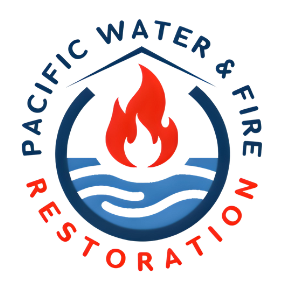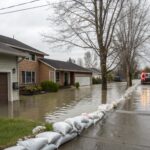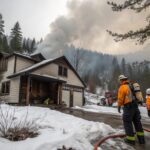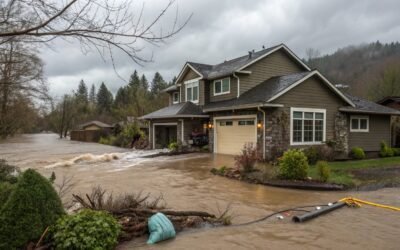Introduction: Why Tigard Residents Need to Be Prepared
Nestled in Washington County just southwest of Portland, Tigard combines suburban comfort with natural beauty. However, this picturesque location also faces specific natural disaster risks including flooding, severe winter storms, wildfires, and the looming threat of a Cascadia Subduction Zone earthquake. Recent years have demonstrated that preparation isn’t just advisable—it’s essential for Tigard residents.
According to the Oregon Office of Emergency Management, less than 40% of Oregon households have comprehensive emergency plans in place. For Tigard residents, understanding local risks and having proper restoration resources can significantly reduce recovery time and costs when disasters occur.
At Pacific Water & Fire Restoration, we’ve helped numerous Tigard families and businesses recover from property damage. This guide provides practical steps to prepare before disaster strikes, respond effectively during an emergency, and navigate the recovery process to restore both your property and peace of mind.
Understanding Tigard’s Specific Disaster Risks
Flooding Vulnerabilities
Tigard’s location near Fanno Creek, the Tualatin River, and numerous tributaries creates distinct flood risks:
Key Flood Risk Factors for Tigard:
- Fanno Creek watershed frequently experiences high water during heavy rain events
- Urban development has increased impervious surfaces, intensifying runoff
- Storm drain systems can become overwhelmed during intense precipitation
- Areas near Bull Mountain experience rapid water flow during heavy storms
- FEMA-designated flood zones encompass significant portions of the community
Winter Storm Challenges
- Tigard’s elevation and geography make it particularly vulnerable to winter storms:
- Ice storms can cause widespread power outages and property damage
- Steep roadways become hazardous during snow and ice events
- Tree damage from ice accumulation threatens homes and infrastructure
- Freezing temperatures can cause pipe bursts and water damage
- Power outages during cold snaps create secondary damage risks
Wildfire Concerns
While not in the highest risk zone, Tigard faces increasing wildfire threats:
- Urban-wildland interface areas face elevated risk
- Drought conditions exacerbate wildfire potential
- Air quality impacts from regional fires affect health and property
- Ember transport can threaten properties even far from fire lines
- Cook Park and Tigard’s greenspaces can become vectors during dry conditions
Earthquake Preparation
Oregon’s position along the Cascadia Subduction Zone puts Tigard at risk for a major seismic event:
- Older buildings may have significant structural vulnerabilities
- Liquefaction risk exists in areas with certain soil compositions
- Infrastructure damage could isolate neighborhoods
- Utilities may be disrupted for weeks or longer
- Secondary hazards like landslides compound earthquake risks
Before Disaster Strikes: Creating Your Preparedness Plan
Essential Emergency Supplies
- Every Tigard home should maintain an emergency kit with:
- Water (one gallon per person per day for at least three days)
- Non-perishable food (minimum three-day supply)
- Battery-powered or hand-crank radio with NOAA weather alerts
- Flashlights and extra batteries
- First aid kit
- Whistle to signal for help
- Dust masks, plastic sheeting, and duct tape for sheltering in place
- Moist towelettes, garbage bags, and plastic ties for sanitation
- Wrench or pliers to turn off utilities
- Manual can opener
- Local maps
- Cell phone with chargers and backup battery
- Cash in small denominations
- Important documents in waterproof container
- Prescription medications and glasses
Pro Tip: Store supplies in easily accessible containers and check them twice yearly when you change your clocks for daylight saving time.
Property Protection Measures
Implement these preventative measures to reduce potential damage:
For Flood Prevention:
- Install check valves in plumbing to prevent backups
- Elevate electrical systems and appliances
- Consider waterproofing basement walls
- Maintain proper drainage around foundation
- Keep valuable items on upper levels when possible
- Clear storm drains near your property before rainy seasons
For Winter Storm Preparation:
- Insulate pipes in unheated areas
- Allow faucets to drip during extreme cold
- Keep gutters clean to prevent ice dams
- Trim trees to remove weak branches
- Have alternative heating sources ready with proper ventilation
- Consider generators for critical power needs
For Wildfire Protection:
- Create defensible space by clearing vegetation within 30 feet of structures
- Use fire-resistant building materials when possible
- Clean gutters regularly to remove flammable debris
- Keep firewood and combustibles away from home
- Screen vents and openings to prevent ember entry
Documentation & Insurance Considerations
Before disaster strikes, properly document your property:
- Maintain a detailed inventory of possessions with photos/videos
- Store important documents in waterproof containers
- Keep digital backups of critical records in cloud storage
- Review insurance policies for adequate coverage
- Understand exactly what your policy covers for different disaster types
Important Insurance Note: Standard homeowners policies often exclude or limit coverage for flood damage. The National Flood Insurance Program (NFIP) and private insurers offer specific flood policies that Tigard residents should consider, especially in flood-prone areas.
During a Disaster: Immediate Response Actions
Safety First: Evacuation Protocols
When disaster threatens, knowing when and how to evacuate is crucial:
- Follow all emergency official instructions immediately
- Have multiple evacuation routes planned in advance
- Establish a family meeting place outside the affected area
- Keep emergency contact information readily available
- Have a communication plan for family members
Tigard Evacuation Resources:
- Sign up for Washington County emergency alerts at WC-Alert
- Monitor local news stations and emergency radio broadcasts
- Review evacuation routes at Washington County Emergency Management
- Know the locations of emergency shelters (Tigard High School is a designated emergency shelter site)
Protecting Your Property When Time Allows
If you have advance warning and it’s safe to do so:
For Approaching Floods:
- Move valuable items to higher levels
- Place sandbags in strategic locations (available at Tigard Public Works during flood warnings)
- Turn off electricity at the breaker
- Disconnect appliances
- Secure outdoor items that could be swept away
Before Winter Storms:
- Insulate pipes
- Clear rain gutters
- Trim tree branches
- Secure outdoor items
- Have snow removal tools ready
- Fill vehicles with fuel and park away from trees
For Power Outage Preparation:
- Turn refrigerators and freezers to coldest settings beforehand
- Prepare backup power for critical medical devices
- Have alternative communication methods ready
- Unplug sensitive electronics to prevent surge damage when power returns
After Disaster Strikes: The Recovery Process
Immediate Assessment and Safety Checks
Before returning to your property:
- Wait for official clearance to return
- Check for structural damage before entering
- Be alert for gas leaks, electrical hazards, and contaminated water
- Document all damage with photos and videos before beginning cleanup
- Contact your insurance company promptly
- Begin mitigation efforts to prevent secondary damage
Safety Warning: Never enter a building that appears structurally unsound. If you smell gas, detect electrical issues, or suspect contaminated water, contact professionals immediately.
The Restoration Timeline: What to Expect
Understanding the restoration process helps manage expectations:
Phase 1: Emergency Response (24-48 hours)
- Property assessment and safety evaluation
- Water extraction and debris removal
- Board-up and tarping services
- Initial drying equipment placement
- Temporary structural supports if needed
- Security measures implementation
Phase 2: Mitigation (3-7 days)
- Complete water removal
- Thorough cleaning and disinfection
- Removal of unsalvageable materials
- Continued drying and dehumidification
- Odor treatment
- Mold prevention measures
Phase 3: Restoration (Varies by damage extent)
- Structural repairs
- Replacement of damaged materials
- Reconstruction of affected areas
- Systems testing and verification
- Final cleaning and detailing
- Property returned to pre-loss condition
Working With Insurance and Restoration Professionals
Navigating insurance claims and restoration work:
- File claims promptly with detailed documentation
- Maintain a log of all communications with insurance
- Get multiple estimates for restoration work
- Verify credentials of all restoration professionals
- Understand the scope of work before approving
- Request regular updates throughout the process
Pro Tip: At Pacific Water & Fire Restoration, we can work directly with your insurance company to streamline the claims process, providing detailed documentation, estimates, and professional assessment to ensure you receive appropriate coverage.
Special Considerations for Tigard Properties
Tigard’s Unique Housing Stock
- Tigard’s diverse housing presents specific restoration challenges:
- Older homes in downtown Tigard may require specialized restoration approaches
- Newer developments near Bull Mountain have modern construction considerations
- Condominium and townhome communities require coordination with HOAs
- Mid-century homes have specific construction materials and methods
- Properties near Fanno Creek may have recurring moisture issues
Commercial Property Restoration
For Tigard’s many businesses, particularly in the Tigard Triangle and along Pacific Highway:
- Business continuity planning affects restoration priorities
- Inventory and equipment protection requires specialized approaches
- Customer/client communication during restoration is essential
- Historic commercial buildings may need specialized treatments
- Retail spaces have unique air quality requirements post-disaster
Learning From Local Experience: Tigard Case Studies
February 2021 Ice Storm Response
When Tigard experienced severe ice storms in February 2021, our restoration team:
- Responded to multiple pipe burst emergencies within 30 minutes
- Implemented rapid water extraction to prevent secondary damage
- Used advanced structural drying techniques
- Coordinated with insurance adjusters for expedited claim processing
- Restored homes to pre-loss condition within 2-3 weeks
Fanno Creek Flooding Recovery
Following flooding in the Fanno Creek area:
- Comprehensive water extraction and sanitization prevented mold growth
- Specialized drying equipment preserved hardwood floors in several homes
- Content restoration saved irreplaceable family heirlooms
- Structural repairs restored homes to pre-flood condition
- Preventative measures reduced vulnerability to future flooding
Building Long-Term Resilience: Beyond Basic Recovery
Community Resources in Tigard
Tigard offers several resources to help residents prepare and recover:
- Tigard CERT (Community Emergency Response Team) training programs
- Neighborhood emergency planning assistance through Neighborhood Networks
- Washington County Emergency Management resources
- Local contractor referral networks for preventative improvements
- Utility assistance programs for disaster-affected residents
Creating a More Resilient Property
As you rebuild, consider these improvements:
- Install impact-resistant roofing materials
- Upgrade to water-resistant flooring options
- Consider seismic retrofitting for older structures
- Install backwater valves for flood protection
- Upgrade insulation for better energy efficiency
- Consider weather-resistant exterior materials
- Implement smart water detection systems
- Install whole-home surge protection
Local Infrastructure and Municipal Preparation
Tigard has invested in several disaster preparedness initiatives that residents should be aware of:
- Fanno Creek flood mitigation projects reduce some flooding risks
- Tigard’s Public Works Department maintains emergency response equipment
- Washington County’s Emergency Operations Center coordinates regional response
- Mutual aid agreements with neighboring communities enhance resources
- Critical infrastructure has received seismic upgrades
- Communication systems have redundancy for emergency situations
Conclusion: Building a More Resilient Tigard
Natural disasters are inevitable in the Pacific Northwest, but catastrophic damage doesn’t have to be. By understanding Tigard’s specific risks, taking proactive preparedness measures, knowing how to respond during emergencies, and having a restoration plan ready, you can significantly reduce both the impact and recovery time when disasters occur.
At Pacific Water & Fire Restoration, we’ve helped countless Tigard residents recover from water, fire, storm, and mold damage. Our IICRC-certified professionals understand both the technical aspects of property restoration and the emotional challenges families face during these difficult times.
Remember that preparedness is an ongoing process. Review your emergency plans regularly, update your supplies, and continue to make improvements to your property. With each step you take, you’re building resilience for whatever challenges nature may bring to our Tigard community.
Next Steps: How We Can Help
For Immediate Emergency Response: Call our 24/7 emergency line at 503-201-7337
For Preventative Assessments:
- Schedule a free property evaluation
- Request our detailed emergency preparedness guide
- Sign up for our seasonal maintenance reminder service
- Consult with our experts about specific property concerns
For Restoration Services:
- Water damage extraction and drying
- Fire and smoke damage restoration
- Mold remediation and prevention
- Storm damage repair
- Content cleaning and restoration
- Structural drying and repairs
- Electronic equipment assessment
- Commercial facility restoration
Don’t wait until disaster strikes. Contact Pacific Water & Fire Restoration today at 503-201-7337 or visit PacificWaterAndFireRestoration.com to schedule your free consultation and take the first step toward a more resilient property.
Pacific Water & Fire Restoration is a full-service restoration company serving the Portland metro area, including Tigard and surrounding communities. Our team is available 24/7 for emergency response, and all our technicians are IICRC certified professionals. We work directly with insurance companies to make the recovery process as smooth as possible for our clients.









